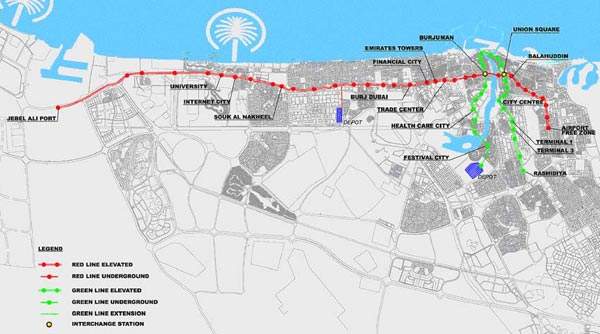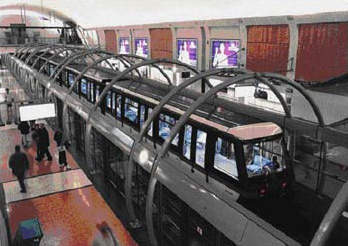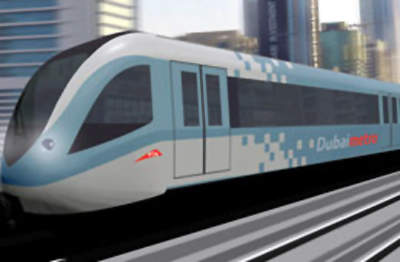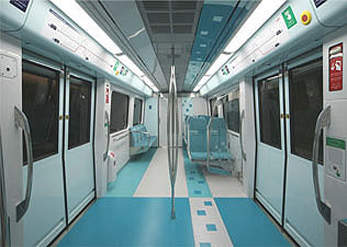Dubai inaugurated its metro network in September 2009, becoming the first urban metro network to run in the Gulf’s Arab states. The system has eased the daily commute for thousands of the workers in the emirate.
With an economy increasingly based upon financial services, air transport, property development and tourism, Dubai has a rapidly growing population and severe traffic congestion problems. The population is forecast to increase by 6.4% annually, rising to three million by 2017.
Dubai Municipality identified the need for a rail system to relieve growing motor traffic levels and support continuing urban development based on studies which began in 1997. Systra was awarded the preliminary engineering contract, and Dubai Rail Link (DURL), a consortium of four companies headed by Japan’s Mitsubishi Heavy Industries (MHI), led the project to build the first two lines of the high-tech driverless rapid transit system. The other consortium members are the Japanese Obayashi and Kajima corporations, as well as Yapi Merkezi of Turkey.
The metro will be fully integrated within the network operated by the Roads & Transport Authority (RTA), a body created in 2005. Routes will be organised around the backbone provided by the rail system.
Around 1.74 million passengers used the metro in its first month, according to the statistics released by the RTA. The average number of passengers travelling on the Red Line is estimated at around 180,000 a day. Green Line passenger capacity is estimated to be 100,000 a day.
The Red Line was the first line to be completed, in April 2010. The Green line was opened in September 2011. Two more lines are planned. The intention is for 320km of metro lines to be in place in Dubai by 2020. Dubai Metro is the longest automated driverless system in the world.
DURL officials are also in the process of negotiations with major local and international companies for acquiring brand naming rights – in other words, advertisement rights – for the stations on Red and Green lines.
In February 2012 the Dubai Metro entered the Guinness World Records book as the longest driverless metro network in the world, spanning 74.69km.
Dubai Metro network early stages and gradual station openings
Groundworks began in February 2006, centred on the 52.1km Red line. As of April 2012 all 29 stations on the Red Line have been inaugurated. Eight of the Red line stations were opened in September 2009. Two stations were opened in January 2010.
Station construction stalled temporarily due to payment disputes – worth $2-3bn – between DURL and its contractors, but resumed in February 2010. Seven more stations opened in April 2010, followed by another three in May 2010 and five in October 2010. Two more stations were opened in March 2011.
In August 2006, a second contract worth $12bn was awarded to the MHI consortium for building the Green line. The Green line runs between Al-Qusais and Al-Jadaf, and links strategic locations including Dubai Airport and Healthcare City. In June 2007, Serco (operator of the Docklands Light Railway in London) was named as preferred bidder for initial consultation and the system’s operation and maintenance.
The Green line was initially planned to open in March 2010, but this was subsequently postponed to September 2011.
Infrastructure and routes of the emirate’s Red and Green lines
The 52.1km Red line has 29 stations, four of which are underground. The line runs from Al-Rashidiya to Jebel Ali and passes the American University of Dubai. It serves an estimated 32,000 passengers an hour. There are plans to extend the Red Line by 15.5km, a move which would add six stations to the route.
The 23km Green line has 18 stations, two of which are transfer stations shared with the Red line. The route is extended to serve the Deira and Bur Dubai central areas, up to the Burjuman and Wafi shopping centres. An 11km extension to the Green line has been proposed, to cover the route between Al-Jadaf and International City station.
The routes run underground in the city centre: from the Sheikh Rashid / Sheikh Khalifa Bin Zayed intersection to the Salahuddin / Abu Bakr Al Siddique intersection on the Red line, and from Garhoud to Oud Metha Road on the Green line.
Elsewhere, trains run on elevated viaducts designed to enhance the urban architecture along the route. The tracks do not cross highways at any point, ensuring full mode segregation. Although taxi, bus and water taxi feeder services were structured to encourage end-to-end use of public transport, the RTA created three park-and-ride sites, the largest of which has 6,000 places.
Underground works have been carried out without affecting buildings. A third-rail power supply was chosen to avoid the visual intrusion of overhead line equipment. All stations, elevated or underground, feature platform screen doors for passenger safety and to facilitate air conditioning.
RTA has introduced ‘feeder bus routes’ to allow commuters to travel from major locations in and around stations. Drop-off zones and a bus and taxi lay-by have also been constructed outside of each station. To further reduce the area’s reliance upon road transport, the authority is considering adding 268km of light rail lines which will serve as feeders to the Dubai Metro.
Rolling stock orders for the first urban metro network in the region
The driverless, fully automated trains are fully air-conditioned and designed to meet Dubai’s specific requirements. Unusual for metro operation, the trains offer standard ‘silver’ class areas, a women and children-only section, plus a first-class ‘gold’ section (a carriage for VIPs). The five-car sets are approximately 75m long, seating around 400 passengers but with standing room for many more.
Rolling stock is being supplied by Kinki Sharyo under a $456.2m contract for 385 cars, the first of which arrived from Japan in March 2008. A total of 87 five-car trains were acquired by the RTA, with 62 used on the Red line and 25 on the Green line. This will gradually be increased to 106 trains.
Storage and maintenance needs to take place undercover due to the heat and dust conditions in Dubai. The main depot is at Al-Rashidiya, and has a capacity for 64 trains. Auxiliary depots are at Jebel Ali and Al-Qusais.
The trains have a maximum speed of 90km/hr, forming a round trip of two hours and 23 minutes for the Red line and one hour and 23 minutes for the Green line.
Signalling and communications along Dubai’s Metro system
The fully automated signalling and communication system is being supplied by Thales Rail Signalling Solutions. The automatic train control system allows headways of between 90 seconds and two minutes.
In 2005, MHI contracted Alcatel (now Alcatel-Lucent) to supply the driverless train control system and a communications system for on-train video surveillance, passenger information, public addresses and the integrated control centre. Trains are Wi-Fi enabled.
The system’s control centre is at the Al-Rashidiya depot. The project’s signalling system is moving block and fully automated with in-cab signalling.
Emergency call boxes and LED systems developed by Trantek are fixed in the trains.
Future for Dubai’s Metro project, expansions and new lines
In full operation, Dubai Metro is projected to carry approximately 1.2 million passengers on an average day, and 355 million passengers a year.
Operating costs, including staff, maintenance and power, should be approximately AED570m a year. This is expected to be met through fares and additional revenues such as advertisement space and joint development.
In May 2007, the 49km Purple line received approval, moving ahead of another future projection, the Blue line. Parsons Brinckerhoff has been contracted for initial design work on the express eight-station line from Dubai International Airport to Al Maktoum International Airport along Al Khail Road.
Construction is yet to begin on the line. Dubai airport has raised concerns as the line also has three check-in facilities which hamper passenger traffic.
The 47km Blue line will link the current international airport with the new Dubai World Central International Airport, which is being built at Jebel Ali, as part of a transport hub. Construction of this line will commence in 2012 and is expected to be completed by 2014.
In April 2008, the RTA announced that the development of the Yellow line, a light rail operation, would be carried out by a consortium including Serco and Alstom.







